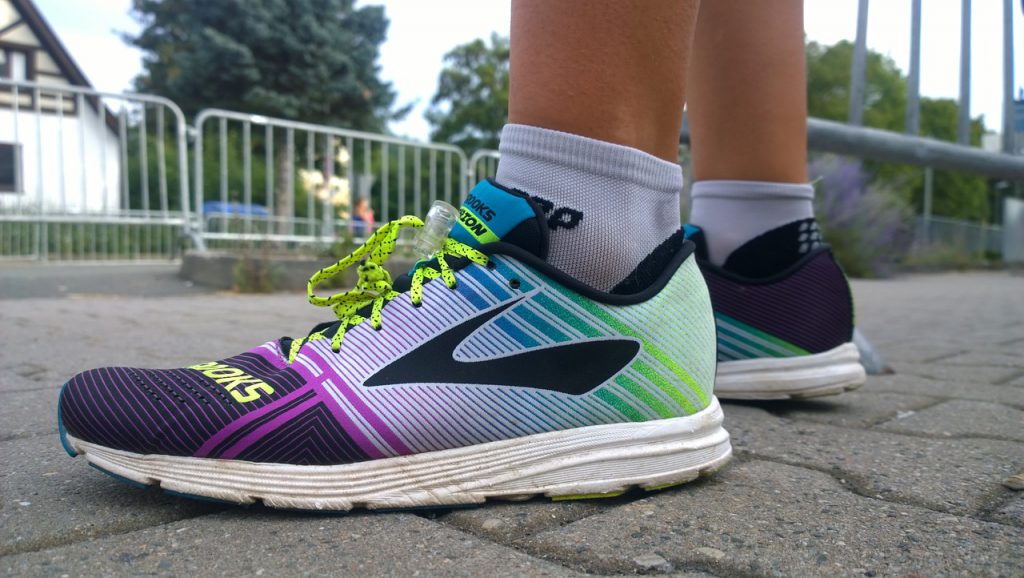RUNNING, HOW TO CHOOSE THE MOST SUITABLE SHOES

Choosing the right shoe is a fundamental aspect of running. In order to avoid the pain and injuries associated with running, including sprains, sports shoes must fit the physical features of runners and the way they train. There are many variables to take into account: this article explains what to pay attention to when choosing running shoes and how to pick the right ones for you.
Running shoes: how to choose them
The first detail to consider before choosing running shoes is your build. Shoes for heavier runners require above-average cushioning, because when you run your weight triples compared to a stationary position.
Second factor: the route. The road you intend to run on is an important consideration. For dirt roads and country lanes, go for shoes that can hold and keep the foot in the right position. Trail running, i.e. running on nature trails, requires safe shoes that protect the joint from injury, while for road running you need shoes that can reduce the impact to the foot from the tarmac, which is a harder and stiffer surface than dirt.
How to choose a running shoe based on the shape of your foot
The shape of the foot is important when choosing footwear because, for example, women have a smaller heel and a wider forefoot, and generally weigh less than men. Women’s running shoes have to meet these precise requirements, which is why they should be tested in a sports shop, if possible with a simulation of running on the spot.
During exertion, the foot has a habit of sliding forwards, a movement which can have unpleasant consequences, such as blisters. It is better to buy slightly larger shoes, so that the toes do not touch the edge of the shoe. The lacing is also important, as it varies with the instep. If the instep is high, the laces should be generous, otherwise minimal laces will suffice.
It is also important to be aware of the arch of your foot, which is responsible for absorbing shocks and is subject to many stresses and rotations during running. It is essential to know how your foot behaves on the ground to choose the right shoe for different types of pronation. In general, the distinction is between overpronators, who wear out the shoe on the inside, and supinators, who wear out the outside of the shoe. An average arch, typical of neutral pronation, does not need a particular model of shoe so there are no particular requirements to consider.
Overpronation is typical of feet that continue to rotate after impacting with the ground, thus promoting inflammation, such as plantar fascitis, pain in the Achilles tendon and generally in all the joints. In this case, the shoe must have a dual density midsole and upper, which is essential if there is discomfort and inflammation.
Supination is typical of people who have reduced biomechanical movement and poor mobility in their lower joints. In this case, neutral styles should be chosen because no special corrections are required.
Running in the right shoes: factors to be consider according to requirements
Choosing the right style also depends on when you use them. When training, it is best to opt for light shoes (no more than 400 g) and ensure good comfort. For competitions, on the other hand, go for higher-performance shoes weighing less than 300 grams.
Running shoes are divided into 7 categories ranging from A0 to A7, and understanding the differences helps to determine your choice.
- Category A0 running shoes: minimalist footwear weighing between 200 and 350 g. These shoes are suitable for fast and clean strides. Free of unnecessary elements, having a single layer sole, they do not interfere with the natural movement of the foot, allowing the toes to move freely.
- Category A1 running shoes: also referred to as super-light or racing shoes, these weigh less than 250 g and are suitable for racing competitions by professional runners and people who have no arch support problems. They don’t provide much stability and support for the foot.
- Category A2 or intermediate running shoes: these weigh between 240 and 300 g on average. They are the right choice for runners who train or compete exclusively on the road. Ideal for people of medium weight and build, they offer moderate stability and foot support while providing the lightness needed for fast performance.
- Category A3 running shoes: this category ensures maximum cushioning and includes shoes that can weigh up to 400 g. They are preferred by runners who love running as a sport above all else but still want a comfortable shoe. There is a big height difference between the heel and the forefoot. This protects the Achilles tendons and heel from potential injury. Ideal for neutral pronation or supination, they are perfect for individuals who weigh over 80 kg. They reduce the athlete’s speed in favour of stability and safety.
- Category A4 running shoes: equipped with supports to prevent overpronation, these are essential for people whose foot control when running is less than perfect.
- Category A5 or Trail Running shoes: essential for people who are passionate about running in nature. Joint protection is the imperative for these shoes, which put maximum support for the foot ahead of performance.
- Category A6 running shoes: shoes in this category are classic jogging shoes, i.e. comfortable and sufficiently cushioned footwear suitable for occasional runners who only run on flat, paved roads. They are not recommended for frequent runners, experienced runners, competitive runners or anyone who loves unpaved surfaces.
- Category A7 studded running shoes: these are super-light shoes, weighing less than 200 g, suitable for athletes who run in competitions and practice athletics. They are not cushioned and have a series of spikes that promote grip on the running track.
Running shoes: when to replace them
Every running shoe has a maximum mileage, during which it ensures optimal performance, and to know when to change them it is useful to keep track of how far they have travelled, for example by using special apps that update with each run.
If you don’t track mileage, the only way to know when to replace your running shoes is to check the details carefully. In fact, the appearance can reveal the state of wear of your footwear. For example, just check:
- Any holes in the upper
- The state of the foam in the midsole, if it seems deflated or particularly deformed;
- The condition of the tread, whether it is particularly worn or the studs are almost smooth.
The general advice is to ask an expert or go to a specialised shop!




